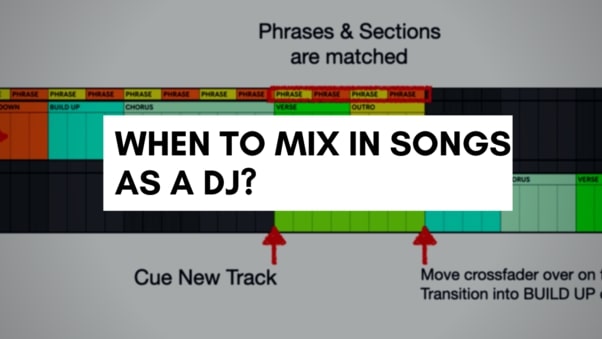
Knowing when to mix in DJ songs is an essential skill that all DJs, great or small, will come across in the DJing learning process.
When to Mix in Songs as a DJ?
Music is structured by sections, e.g. chorus or verse. A section is built up of 32 beat phrases. DJs can count beats within a phrase, or listen out for drum fills or crash cymbals indicating the end of a phrase. Cue points can be set to indicate the end of a phrase or section in DJ software. These techniques help DJs to start mixing in a new track.
Learning when to mix in songs is a very valuable skill to have and acquire when in the process of becoming a DJ learning how to mix. I remember it as if it was yesterday when I learnt about phrasing and song structure, the penny dropped and I become much more of a confident DJ.
First, Understand Song Structure
It’s important to understand the structure of a song to help you DJ. I knowing song structure allows you to better navigate and plan your way through where to best match and phrase match throughout your DJ set.
At first this might seem a lot to take in, trust me when I say this, once you’ve got to grips with song structure and phrase matching, after a while it will seem second nature to you. Almost as if you’ve got auto-pilot switched on.
All song structures are different but some genres have similarities so it does help if you’re a DJ sticking to one genre or even sub-genre.
The build up of an electronic music track is usually built up of:
- Intro
- Build up
- Drop / Verse
- Chorus
- Break down
- Build up
- Chorus
- Verse
- Outro
Below I’ve taken ‘Battle for Middle You‘ by Julio Bashmore.
As you can see the song structure is very similar to the structure that I’ve stated above.
Remember though that not all song structures will be the same across all tracks in your scene or music genre.
Some song structures are made up of similar song structures or might have longer sections.
Such as in the ‘Battle for Middle You’ by Julio Bashmore track, the chorus after the second drop is double the amount versus before the drop.

Notice the yellow and orange bars are consistent throughout the track, each made up of 32 beats per phrase.
Note that in different genres of music phrases may be slightly different in length, maybe even 8 or 16.
In a close up of the beginning of the music track you can see the intro is made up of four phrases whereas the verse is only technically two phrase.

Beats, Bars & Phrases
It’s important to know that when you’re looking to gain the skill of phrase matching, you need to know how to count bars within a phrase and a section in a song.
It’s pretty simple to understand and easy to get to grips with.
Practice Tip: When you’re starting out as a beginner DJ you can simply count four bars of 8 beats. Then you will have counted one phrase. Repeat this to help you beat match phrases.
See below at the top of the image, the intro section is made up of four 8 beat bars, forming one phrase within the intro.

As you can see DJing is a skill that requires you to understand music as building blocks.
Phrases are the sum of 8 beat bars. Essentially micro pieces of a song structure. The foundation.
Song sections (e.g. chorus or intro) are the building blocks of both 8 beat bars and phrases. Macro pieces of a song structure.
Phrase Matching
Ok so now you know about:
- Song structure
- Phrases
- 8 bar beats
Your next skill is to understand how you can pick which phrase on each song to start mixing together.
My golden rule is generally not to mix in a track when a chorus is playing. Usually a chorus is the cream of the crop and most melodic part of a track that people like, dance and sing a long to, especially if there are vocals in the track.
Can you see why it’s so important to know about song structure? Imagine mixing over the chorus of a really popular song? You be the flavour of the month as a DJ would you now!
A good way to think about mixing phrases together is by letting the Chorus end and flow into the verse.
Usually the Verse, I find, has less elements to the music track playing and therefore is a good section of a song to mix in the intro of a new track.
Let’s visually map out and look at how two phrases would match together in this scenario.
Firstly. The existing track is playing.
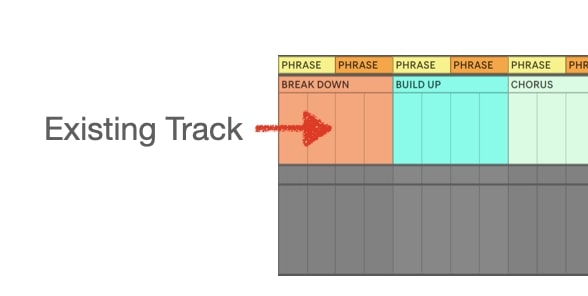
Secondly, your job is to find a cue point
Cue the new track at the start of the intro, and start mixing it in at the beginning of the Verse on the existing track.
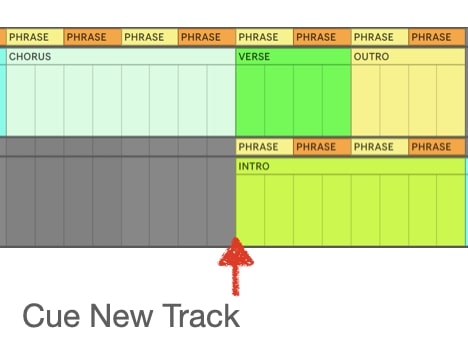
Third. Make sure the phrases match & tempo is correct.
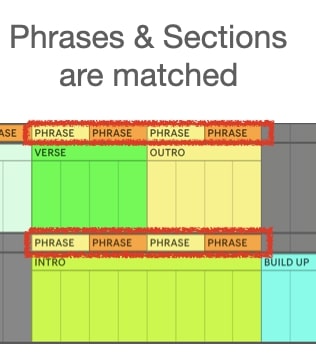
Fourth. Cross fade out of existing track into new track ‘Build Up’ section
Where the arrow is below that’s where you would have fully moved the cross fader over to the new track. Before this point in the intro, use the cross fader to smoothly bring in the new track.
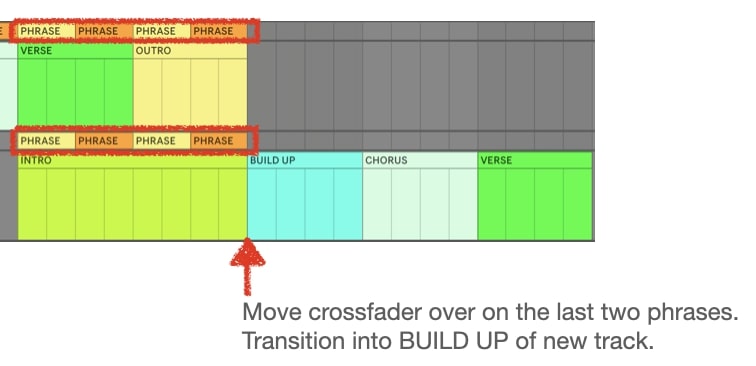
You may be thinking at this point, how to actually know when the start of a new section is playing, or is about to play.
In this scenario above, you can easily count the amount of phrases from the beginning of the intro and throughout the song. But this is not the only technique for find cue points at the beginning of sections to help you phrase match.
Note: you don’t always have to start at the beginning of a section e.g. intro, to start mixing. You can start half way through an intro or build up. As long as the phrases match up and the mix can sound smooth, then go for it.
Listening for Cues
This is a great way to understand how music sections are structured. And the Julio Bashmore track here is great for this example.
Check out the intro…
There are two phrases within the first half of the intro.
At the end of each phrase there’s an audio cue to signify the ending of a phrase.
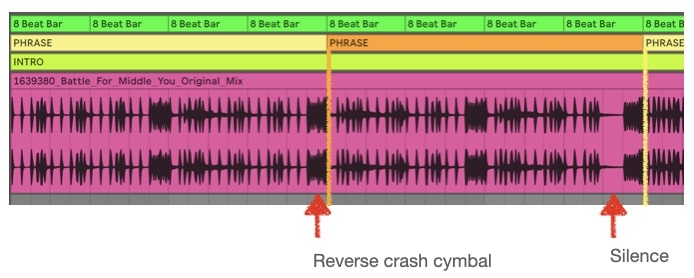
The first being a reverse cymbal into a crash cymbal.
The second being silence of the drum pattern, allow for the synth sound to pop through. Having the silence signifies that there’s a change coming the music track and also shows that it’s the end of the second phrase.
This is a great way for you to get to grips with listening to music in a different way and become a better DJ.
Planning for Visual Cues
The other method you can use is more visual than purely listening.
If you use DJ software for example, you can go through a track and pin point each section of a track. You can also highlight which phrase you feel is best as a point to start mixing into the track.
All of this “marking” can be achieved with setting ‘Cue Points’ and ‘Memory Cues’ in Rekordbox or Serato DJ, most DJ software allows you to do this.
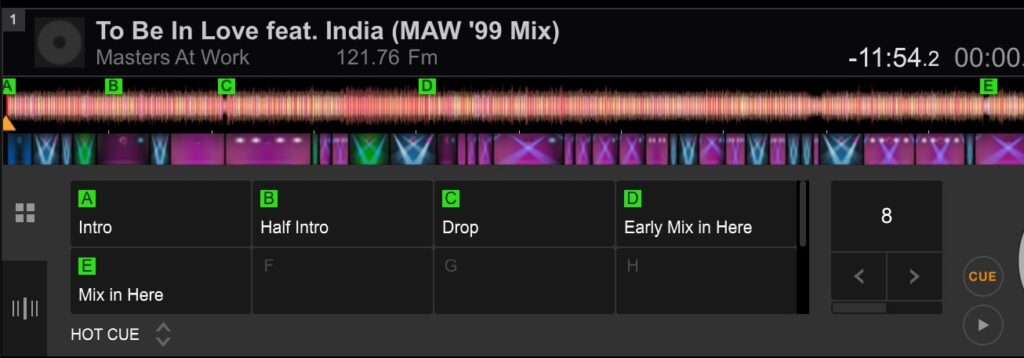
As you can see in the image of Rekordbox above, I’ve used HOT CUES to help put in markers to represent the sections or phrases that I know I can either use as a Cue point or a marker of when to start mixing in a new track.
Learn Points to Remember
- Sections of songs can vary in size (amount of bars and phrases).
- Phrases usually consist of 32 beats, but can vary depending on genre of music.
- Phrases help you perform smooth transitions in your DJ mixes.
- You can count 8 beats per bar, some people prefer to count 4 beat bars (my brain prefers 8 beat bars).
- Map out hot cues for visual markers to mix your music.
- Listen out for drum fills, reverse crash cymbals, silence and synth risers to help you map out phrases and sections of tracks in your memory.
Related Questions
How do DJs know what song to play next?
DJs count beats within a phrase or listen out for a signifying sound at the end of a phrase, such as a drum fill or reverse cymbal sound. This is an indicator for DJs to cue and start beat matching their new music track.
How do you mix DJ songs?
DJs use cueing and cue points to know when to mix in new songs into each other. Cueing can be heard through the headphones and not the speakers. DJs can beat match two music tracks before mixing them together using the crossfader on a mixer.
What it called when a DJ mixes two songs together?
It is called ‘beat matching’, ‘mixing’ or ‘blending’ when two music tracks together.

